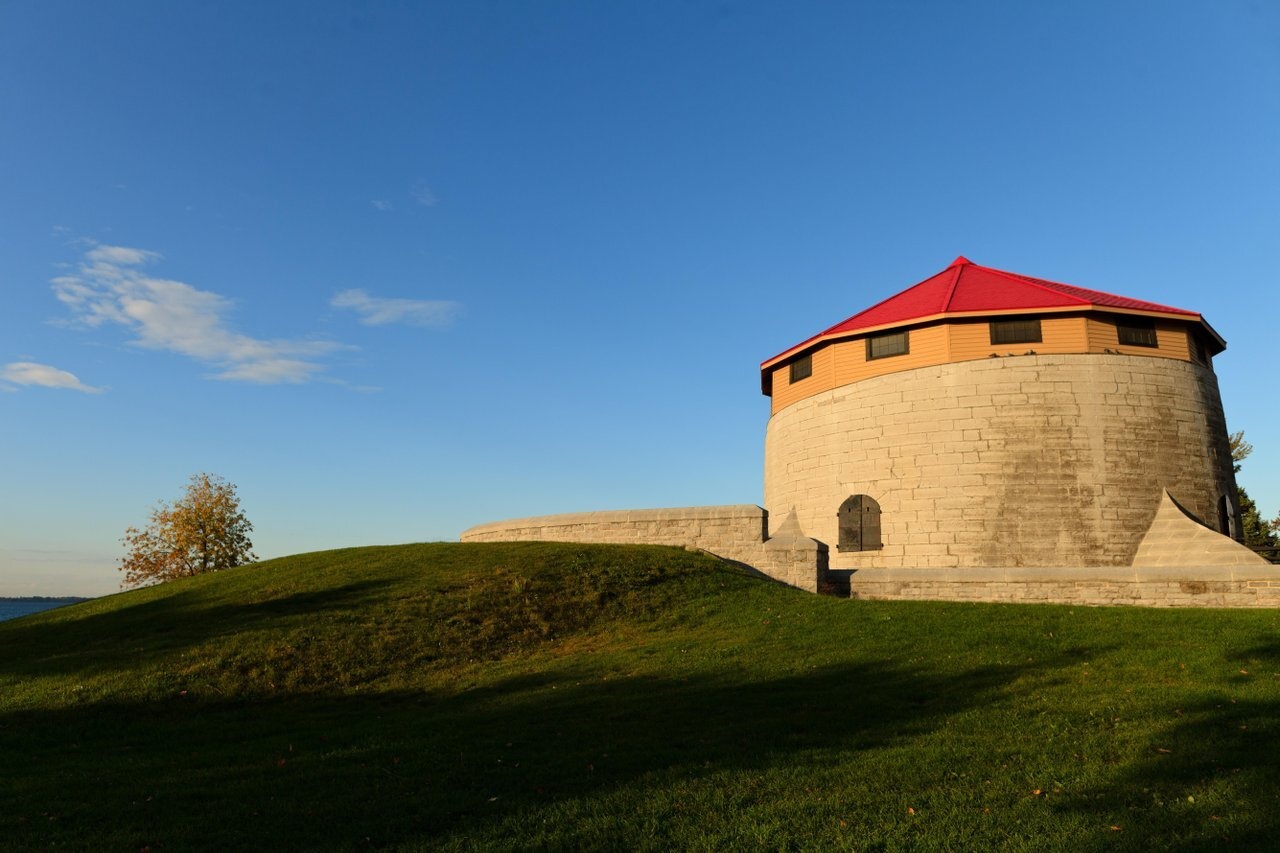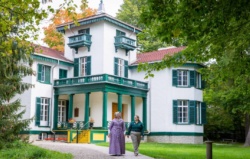
Stone, Silence, and Stories: The Living Legacy of Murney Tower
There’s something about Kingston’s Murney Tower that makes time fold in on itself.
The thick stone walls hold Lake Ontario’s damp breath. Iron hinges groan without warning. And when the wind comes in off the water just right, you can almost hear boots on the stairs or the scrape of a cannon being wheeled into place.
Built for war and shaped by peace, Murney Tower has stood on Kingston’s shoreline for nearly two centuries — solid, stubborn and slightly strange. Locals will tell you it was meant to be called Murray Tower, named for Sir George Murray, a British military figure. But the land belonged to the Murney family, and the name stuck. The stone over the entrance still bears the compromise: “MURNAY,” etched in a kind of colonial shrug. According to the Kingston Historical Society, the hybrid name came about after the “R” in “Murray” was recarved into an “N,” likely by a local stone mason with strong opinions and limited time.
This year, the tower marks 100 years as a museum, a century of welcoming visitors into its circular hold. But long before the public ever stepped inside, the tower was part of the landscape’s deeper memory. It was a place of tension, defence, and uneasy peace.
In the early 1840s, tensions between Britain and the United States were flaring again — this time over the Oregon Territory. President James K. Polk’s campaign slogan, “Fifty-four forty or fight!” reflected the heated land disputes out west, but the strategic focus back east was squarely on Kingston. Sitting at the junction of the St. Lawrence River, Lake Ontario, and the Rideau Canal, Kingston was viewed by British authorities as the key to Upper Canada’s military and economic security. So, in a bit of imperial overcompensation, they built forts. Lots of them.
Murney Tower was one of four Martello towers constructed in Kingston between 1846 and 1848, alongside Shoal Tower, Fort Frederick, and Cathcart Tower. Murney was designed to guard the western approach to the harbour and the nearby naval dockyard. It never saw a shot fired in anger, but its looming presence was deterrent enough to keep uneasy peace in place.
Construction began in February 1846 and was completed, in a feat of Victorian engineering hustle, by November of that year. Made from locally quarried limestone, the walls are up to 15 feet thick on the lake-facing side, built to absorb and deflect cannon fire. The landward side is just eight feet thick, presumably because they figured if the enemy had made it that far inland, it was already too late.
The tower’s defensive features include a dry ditch, which is a moat without water, that circles the base, and four caponiers (mini bunkers jutting into the ditch) with rifle slits to keep any would-be attackers from getting comfortable near the foundation. The gun platform above once held a 32-pounder Bloomfield cannon capable of a full 360-degree swivel, perfect for scanning the lake for invaders or, more often, wayward boats and ducks.
Fun fact: While most Martello towers around the world were built without roofs, the Canadians said “no thanks” to snow-filled fortresses. Murney got its protective wooden roof in 1849, a practical Canadian twist on a British design.
Though its defences were impressive, Murney Tower never saw combat. Instead, it lived a quieter, though no less complex, existence as a military barracks. From 1848 to 1885, it housed soldiers from the Royal Canadian Rifle Regiment, a unit made up largely of long-service men considered less likely to desert. At its peak, the tower accommodated up to six families. They shared the main floor as communal living quarters, with cooking fires, cribs, and soldiers’ boots all crammed together in stone-walled intimacy.
One of those families left a lasting mark: Sergeant Thomas Pugh, his wife Martha Mary, and their seven children. Their daughter, Murney May Pugh, was born inside the tower in 1882 — a fact that might sound charming until you picture giving birth in a limestone drum with questionable ventilation and a cannon overhead. Murney May would go on to become a nurse during the First World War, a life of service shaped, perhaps, by her start in one of Canada’s strangest family homes.
After the military abandoned the tower in 1885, it was mostly forgotten. Left to the elements, it fell into disrepair. Looters stripped bricks from the main floor and, in one gutsy heist, even managed to steal a 1,000-pound cannon. The real tragedy came in 1921 when part of the deteriorating roof blew off during a windstorm and fatally injured a young boy playing nearby. That event shocked the community into action.
Fun fact: The tower’s powder magazine was constructed using wooden nails instead of iron ones to prevent sparks. That level of care is either extremely thoughtful or extremely anxious. Probably both.
According to the Kingston Historical Society, it was this moment that sparked efforts to restore the site. By 1925, the tower reopened as a museum — one of the first examples in Canada of military preservation led by a local heritage group.
Today, the tower offers three floors of immersive exhibits. The ground floor, once a noisy, soot-covered barracks, now displays 19th-century uniforms, weapons, and household items from the garrison era. The basement — cool and slightly eerie — includes the powder magazine and the caponiers, where visitors can peek through the same rifle loopholes soldiers once used. And up top, the gun platform still hosts the original cannon, offering panoramic views of Kingston’s harbour and cityscape.

Traveller tip: Bring a camera. The view from the gun platform is one of the best photo ops in the city — especially around golden hour when the limestone glows and the lake goes still.
Potty Preference: One thing Murney Tower does not have is a public washroom. The closest facilities are at Richardson Beach Bathhouse or across the road in City Park. Plan ahead — the 19th-century soldiers made do with chamber pots, but you don’t have to.
As Murney Tower celebrates 100 years as a museum in 2025, expect a host of commemorative events. Spring and summer will feature open houses, guided tours, and family-friendly programming that connects local stories to Canada’s broader military past. Parks Canada, the Kingston Historical Society, and other local partners are collaborating on fresh interpretation tools and community engagement — and it’s all part of a broader reminder that Kingston has always been more than just a pretty waterfront town. It’s been a fortress, a home, and a place that remembers.
And for those intrigued by bigger stories, Murney Tower is part of the Kingston Fortifications that, along with the Rideau Canal, earned UNESCO World Heritage Site designation in 2007. So yes — those stone walls are globally recognized. Come enjoy a little time-travelling on an internationally certified schedule.
Murney Tower isn’t flashy, but it’s foundational. It’s been used, reused, renamed, and reinterpreted over two centuries. That endurance, and the quiet debate baked into its name, is part of what makes it matter.
Final tip? Go ahead and climb the tower. The stairs are steep, the air is cool, and the ghosts are probably friendly. Probably.
While you’re in the region, keep an eye out for other anniversaries in 2025:
Great Lakes Museum - celebrating 50 years
Kingston 1000 Islands Cruises - celebrating 50 years
L&A MEGA Geocaching events - celebrating 25 years
READ ALSO


